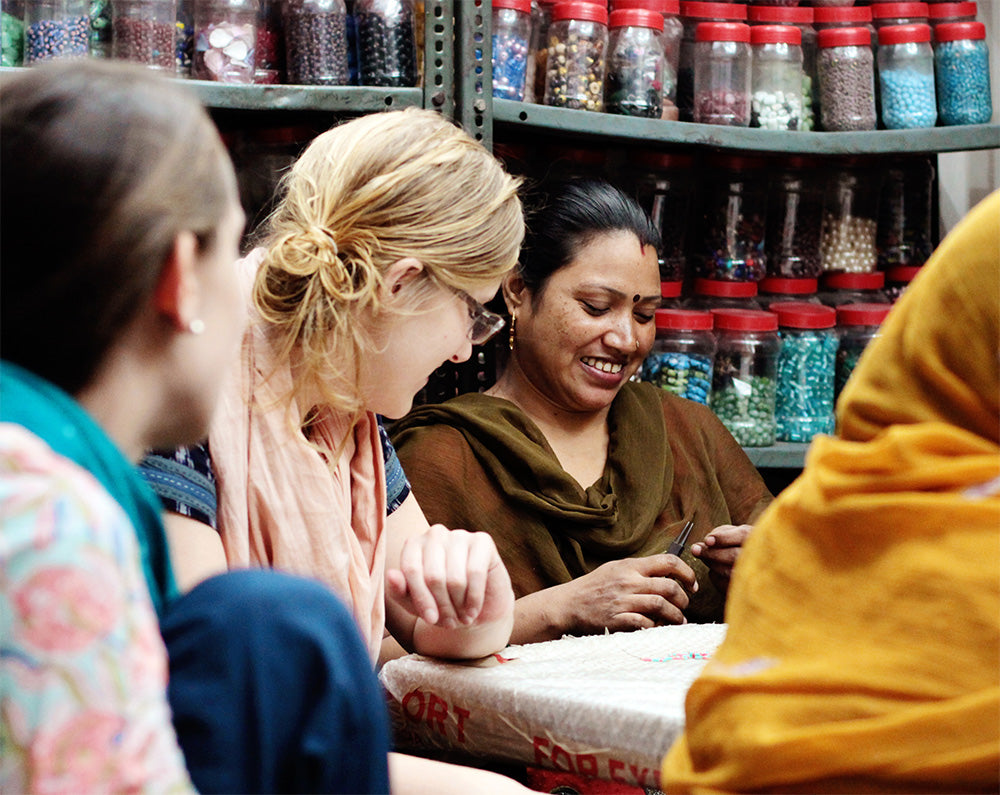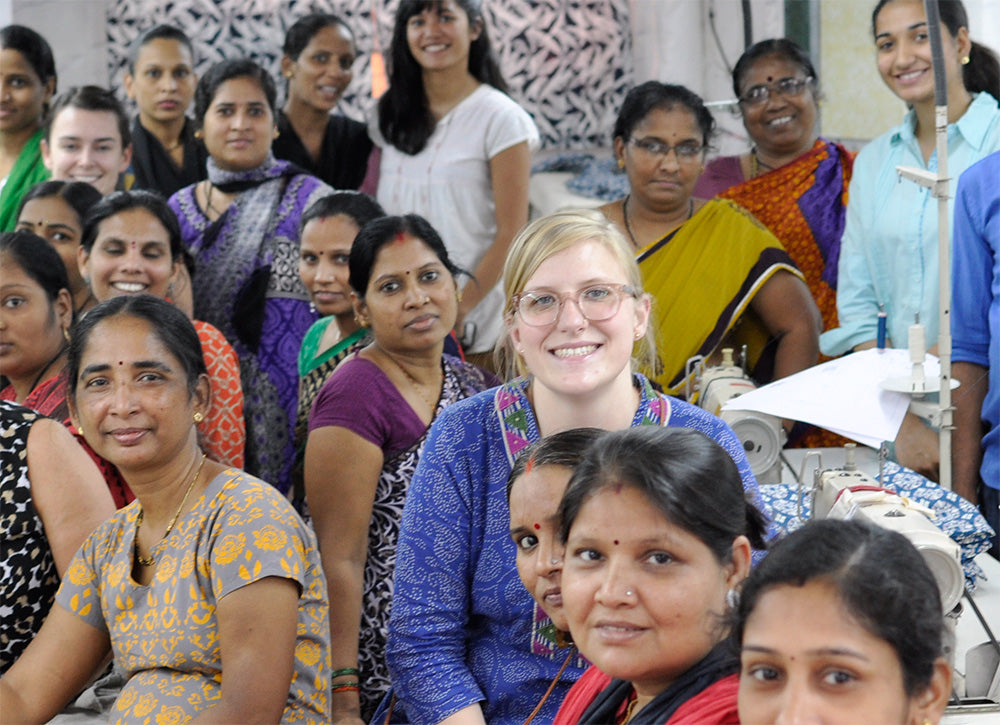When Maureen founded Mata Traders over ten years ago, it became evident pretty quickly that the demand for fair trade clothing was going to keep us busy. Really busy. With so many apparel and jewelry pieces being produced, we needed someone to keep an eye on the production quality and consistency, and boy, was Taylor the person for the job. Once or twice a year she took trips with our designer to India and Nepal, spending time with our partner artisans on skill development and establishing systems to better our products and improve the processes with which they are made.

This summer, she has ventured out on her own to start a new business, so before she left we picked her brain about the last 8 years at Mata!
An Interview with Taylor, our former Fair Trade Production Manager
1) What exactly does the Production Manager do at a fair trade fashion company?
I monitor the quality and timeline of the product from order placement to customer delivery.
My job also involves a lot of relationship management. We work with suppliers who are first and foremost social impact organizations and we create products made from handmade, imperfect processes, which also happens to be what makes the collection unique. There are also challenges when working to overcome timeline and quality issues due to extreme weather, artisanal methods, and of course Indian wedding season :).
In the last two years of working with Mata Traders, I also got to dive into some sustainable development initiatives like measuring social impact and researching the sourcing of organic cotton.
2) What was one of the biggest challenges you had here? As a manager of quality, you have to have some of the most stringent eyes, but you also have to learn what elements are most important to your customer. It’s important to have a priority list of quality points for every brand.
One story to illustrate the extent to which you cannot predict what quality issues might arise….We once had an entire style (about 400 dresses) that all smelled powerfully of spices. Whether there was a cooking extravaganza at the producer group the day packaging took place, or maybe the style was packed in a shipping container next to a delivery of bulk spices – I was never able to find out. We knew that the smell would be less than desirable for our customers and had to do something about it. I had friends and family in the theater world, working on period costumes that are too delicate to wash. Their solution for getting out the worst smells? Vodka. Spraying vodka on fabric simultaneously eliminates odors and dries quickly – without harm. We had to take all 400 dresses out of their packages, hang them on hangers, making sure the hang tag was inside, and then spray them all front and back. Let’s just say I had a blister on my thumb from the spray bottle :). At a small company, this kind of problem solving is commonplace.

3) What is something you have learned from the artisans?
- Always keep trying
- People have the ability to overcome some of the harshest life challenges
- Life takes hard work
- I’ve always loved traveling and seeing the practice of the Hindu Ayudha Puja, which is a time of worship of one’s tools and instruments. This means tailors honor their sewing machines and adorn them with flowers, farmers- their ploughs, and drivers- their cars.
- When I consider that I don’t have to do anything more than turn on the tap water for safe drinking water at home, I feel like my daily routine is already way less complicated than most of the world.
4) What are you most proud of from your time at Mata?
I’m most proud of my work to help evolve the Mata product development and production calendars to better meet the needs of our store owners. When I started working on production in 2012, we were shipping our spring collection out in April & May, and now we ship it out in February & March. For our Fall/Winter collections, we were shipping orders in October, and now it’s July & August. Looking at how to do this while working within the fair trade business model with artisan processes definitely involves creative thinking and collaboration.

5) What is something people would be surprised to know about the production/QC process? It takes more than 14-15 months to develop a garment from sketch to delivery, and over 45 -90 days to produce some of the handmade fabrics we use (prior to it getting cut and stitched into a garment).
6) How do you quality check the production of each collection?
During development we monitor quality on first garment fit samples, fabric strike offs, garment samples in all sizes, fabric sampling meters, pre-production fabric swatches, pre-production garment samples, mid-production garment and fabric samples, and a local quality agent visits the producers and inspects quality. Whew!
Once shipments arrive at our warehouse, our team inspects a percentage of each style, checking and recording measurements as well as any fabric flaws. We have try-ons of all sizes to see if anything has changed about the fit. Then we can determine if the style is acceptable for our customer or if we have to look further into the inventory to find any defective pieces.
Before the shipments leave India and Nepal our main goal is to support the producer to monitor the quality and prevent any issues. Once the product arrives to our warehouse we like to reflect on the quality of each style throughout the entire process and determine if there is anything to learn for future production cycles.

7) What is done when you visit India compared to what is done at Mata HQ?
In my opinion, the biggest benefit to extended time on the ground visiting producer groups is the chance to problem solve together. Whether it’s discussing upcoming strategic goals or reviewing measurement discrepancies, it’s all done more effectively when both teams can be together. I feel it has significantly contributed to the close working relationship Mata maintains with our producer partners, and has allowed our team to witness change, growth and hardship within their social enterprise organizations, as well.
In India we are giving presentations on quality reports, update on feedback from our customers, challenges and successes. We also spend a significant amount of time inspecting different stages of the production (whether it’s fabric, pre-production samples, or mid-production) and having discussions over our findings. This often includes trying on garments to illustrate how various stitching errors can affect the fit. The garments we design are much more fitted than the wardrobes of those working to produce the collection. It’s helpful to give a more well rounded illustration of the importance of accuracy when connecting certain areas of the garment. I’ve always thought it best if every level of the supply chain has a good understanding of the quality standards needed to satisfy our customers.
It has been such a wonderful opportunity to get to work with our partners. They have become friends and support networks, and I’m very proud of the work we’ve done together.
8) What is your next new venture? What can you tell us about it? My husband and I have wanted to own and run a company together for a long time – we’re both hands-on learners who love to do a lot of different things in a day. Settling on what industry to go into didn’t come overnight, as we knew the right choice would eventually come to us naturally. We’ve landed on launching…drumroll…..a clothing business!! Who’s the customer?! Tall women! As I mentioned, it can take 14-15 months to develop a garment from sketch to delivery, so you won’t be seeing anything from us until a bit later.
